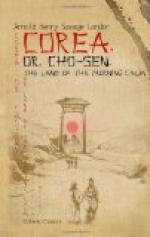One cannot help being considerably puzzled by the differences in the various classes and conditions of the men. To all appearance, the generality of men seem here dressed alike, with this difference, that some are dirtier than others; occasionally one has an extra garment, but that is all. Yes, there is, indeed, difficulty at first in knowing who and what any one is, but with a little trouble and practice the difficulty is soon overcome. In the main the clothes worn by the men are the same, only a great difference is to be found in the way these garments are cut and sewn, just as we can distinguish in a moment the cut of a Bond Street tailor from that of a suburban one. In Corea, the tailor, as a rule, is one’s wife, for she is the person entrusted with the cares of cutting, sewing, and padding up her better-half’s attire. No wonder, then, that nine-tenths of the top-knotted consorts look regular bags as they walk about. The national costume itself, it must be confessed, does rather tend to deform the appearance of the human body, which it is supposed to adorn. First, there is a huge pair of cotton trousers, through each leg of which one can pass the whole of one’s body easily, and these trousers are padded all over with cotton wool, no underclothing being worn. When these are put on, they reach from the chin to the feet, on to which they fall in ample and graceful folds, and you don them by holding them up with your teeth, and fastening them anywhere near and round your waist with a pretty, long silk ribbon with tassels, which is generally let hang down artistically over the right side. When this has been successfully accomplished, the extra length of trousers is rolled up so as to prevent the “unmentionables” from being left behind as you walk away, and a short coat, tight at the shoulders and in the shape of a bell, with short but wide sleeves, is put on to cover the upper part of the body. This coat also, like the trousers, is padded, and reaches almost to the haunches. It overlaps on the right hand side, two long ribbons being tied there into a pretty single-winged knot and the two ends left hanging. In winter time, the forearm, which in summer remains bare, is protected by a separate short muff, or sleeve, through which the hand is passed, and which reaches just over the elbow.




